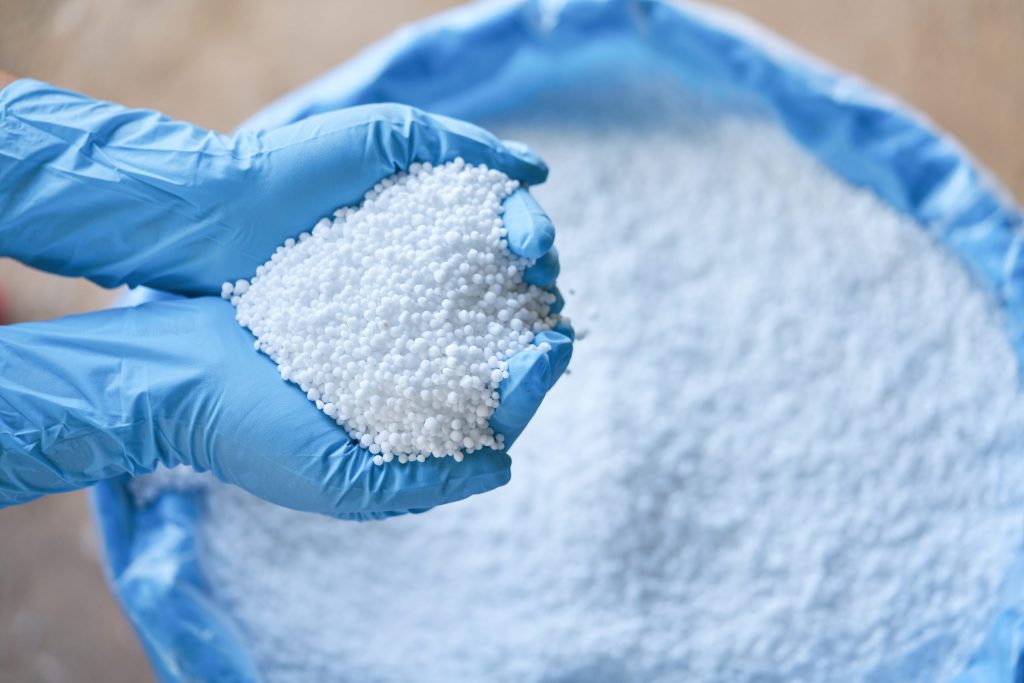Urea is a chemical compound with the formula CO(NH2)2, also known as carbamide. It is the simplest amide of carbamic acid and is widely used in the chemical industry as a raw material for producing plastics, drugs, and resins1. Urea is also used as a nitrogenous fertilizer and feed supplement, and is produced by the metabolism of proteins in all mammals and some fishes2. It is a colorless, odorless solid that is highly soluble in water and practically non-toxic
Types of Urea:
Urea is produced in two forms, granules, and powder. Urea granules are small, round grains with a white or slightly yellow color. Urea powder is a white powder usually packaged in plastic bags. Granular urea is more suitable for agriculture and industries requiring high solubility, while urea powder is used in industries needing a combination with other materials, such as plastic production, adhesives, explosives, etc.
Applications of Urea:
Urea is a versatile chemical compound used in various industries as a fundamental component:
-
Agriculture:
Urea serves as an effective nitrogen fertilizer, enhancing the yield and quality of agricultural products. Over 90% of urea production is used in agriculture as a high-quality nitrogen source.
-
Chemical Industries:
Used as a primary material in producing various chemical products such as plastic, adhesive, resin, explosives, laundry detergent, and teeth whitener. Urea-formaldehyde resin is also utilized in the construction and furniture industries.
-
Pharmaceutical Industry:
Applied in the production of some medications, including tranquilizers, sleeping pills, and kidney stone treatment drugs. Additionally, urea is used as an effective substance in animal protein production.
-
Firefighting Industry:
Urea is used as a flame-retardant substance in firefighting operations.
Price Variability:
Urea prices are influenced by factors like type (granular or powder), quality, packaging, exchange rates, market demand, and transportation costs.
Here is the latest price!
Why Iran?
Russia, being one of the largest consumers of urea globally, relies on imports of this substance. Iran is among the closest and most cost-effective sources of urea for Russia. Due to its geographical location, the transportation cost of urea from Iran to Russia is lower compared to other countries. Iran also maintains high-quality urea production, meeting Russia’s needs in agriculture and chemical industries. In 2020, Iran produced approximately 7.5 million tons of urea, exporting around 6.5 million tons. It was the largest supplier of urea to Russia, exporting around 1.8 million tons in 2019 and approximately 1.5 million tons to India in 2020.
Main Urea Suppliers in Iran:
The urea production industry in Iran is divided into two main sectors: petrochemical and agricultural industries. Petrochemical companies use urea as a raw material for producing downstream products like plastic, resin, adhesive, explosives, etc. Agricultural industries use urea as a nitrogen fertilizer to enhance crop performance and quality.
Presently, seven petrochemical companies in Iran are engaged in urea production. Of these, Pars Petrochemical (Shiraz), Kermanshah Petrochemical, Khuzestan Petrochemical (Khorasan), and Lardgan Urea Chemical are recognized as stock exchange-listed companies producing urea. Razie Petrochemical and Masjed Soleyman Petrochemical are also active in this field, although their shares are not publicly traded. Additionally, companies like Hengam, Zanjan, Golestan, Hormoz, and Hemmat are in the process of establishing and completing urea production projects.
-
Pars Petrochemical:
Established in 2001, Pars Petrochemical went public in 2011. With three production phases, its nominal capacities are 2.15, 2.15, and 1.075 million tons of urea per year. In 2019, Pars Petrochemical produced around 4.8 million tons of urea, exporting about 4.1 million tons. It stands as the largest urea producer and exporter in Iran and globally.
-
Shiraz Petrochemical:
Founded in 1989, Shiraz Petrochemical went public in 2000. With one production phase, its nominal capacity is 680,000 tons of urea per year. In 2019, Shiraz Petrochemical produced approximately 600,000 tons of urea, exporting around 500,000 tons. It is the second-largest urea producer and exporter in Iran.
-
Kermanshah Petrochemical:
Established in 1991, Kermanshah Petrochemical went public in 2002. With one production phase, its nominal capacity is 525,000 tons of urea per year. In 2019, Kermanshah Petrochemical produced around 500,000 tons of urea, exporting about 400,000 tons. It is the third-largest urea producer and exporter in Iran.
-
Khorasan Petrochemical:
Founded in 1995, Khorasan Petrochemical went public in 2006. With one production phase, its nominal capacity is 330,000 tons of urea per year. In 2019, Khorasan Petrochemical produced approximately 300,000 tons of urea, exporting around 250,000 tons. It is the fourth-largest urea producer and exporter in Iran.
-
Lordegan Urea Chemical:
Established in 2005, Lardgan Urea Chemical went public in 2014. With one production phase, its nominal capacity is 325,000 tons of urea per year. In 2019, Lordegan Urea Chemical produced about 300,000 tons of urea, exporting about 200,000 tons. It is the fifth-largest urea producer and exporter in Iran.
Packaging Diversity of Iranian Urea:
Urea is commonly packaged in 50 kg plastic bags or 200 kg metal drums. For urea exports, plastic bags or metal drums are typically used. Domestic transportation can involve trucks and railways, while international transportation may include ships or trains.


